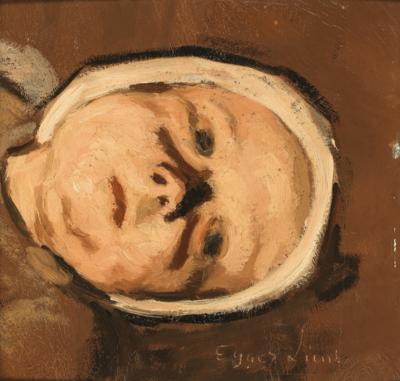Albin Egger-Lienz
(Stribach near Lienz 1868–1926 St. Justina near Bolzano/Bozen)
Das Kind / The Child, c. 1922, signed Egger-Lienz, on the reverse inscribed Egger-Lienz and “Aus dem Bilde die Mütter”, dated 1922, oil on cardboard, 25 x 24 cm, framed
Provenance:
Estate of the artist
his heirs
Private Collection, Tyrol
Registered and illustrated in:
Heinrich Hammer, Albin Egger-Lienz, Innsbruck 1930, p. 285, registered under “1922 Mütter”, study no. 2 (“Zum Kind”), no ill.
Wilfried Kirschl, Albin Egger-Lienz, Innsbruck 1976, vol. II, cat. rais. M 566 (“Zum Kind”), ill. (black/white)
Compare with:
Portrait of the child in the painting “Mütter”, 1922, oil on canvas, cat. rais. Kirschl M 563, Innsbruck Tiroler Landesmuseum Ferdinandeum
“The creative force is nothing other than the ability to become aware of things. They must first be shaped by us, and when this happens powerfully, the image of nature is not changed. Rather, it becomes animated, condensed, meaningful.”
Egger-Lienz, 1922 cit. in: Kirschl, vol. I, p. 359
Until now, this small-format painting depicting a baby in swaddling clothes was only known from a black and white photograph. It is associated with the large-format painting “Mütter” (Mothers, Tiroler Landesmuseum Ferdinandeum, Innsbruck, inv. no. Gem 1296) from 1922 and is comparable, with minor deviations, to the depiction of a newborn in the somewhat earlier painting “Generationen” (Generations) from 1918 (Kirschl M 418), of which a total of four variants exist as independent portraits (Kirschl M 422, 517, 573 and 574).
In a letter of 1925, Egger-Lienz refers to the “formal treatment of the heads” in these paintings, to the way “their organic construction as a whole as well as in detail [becomes] a symbol” and how the “natural form is absorbed and brought to life by the design..., so that it becomes a style from within” (Kirschl, Vol. I, p. 318).
In these parable-like thought-images of the late period, Egger-Lienz symbolises by using the rare motif of the small child the principle of hope in the midst of the great suffering of families scarred by war. Detached from the overarching context of content, the portrait of the innocent child becomes an even more intense symbol of a constant new beginning and of life.
Specialist: Dr. Marianne Hussl-Hörmann
 Dr. Marianne Hussl-Hörmann
Dr. Marianne Hussl-Hörmann
+43-1-515 60-765
marianne.hussl-hoermann@dorotheum.at
23.05.2023 - 18:00
- Realized price: **
-
EUR 44,200.-
- Estimate:
-
EUR 25,000.- to EUR 40,000.-
Albin Egger-Lienz
(Stribach near Lienz 1868–1926 St. Justina near Bolzano/Bozen)
Das Kind / The Child, c. 1922, signed Egger-Lienz, on the reverse inscribed Egger-Lienz and “Aus dem Bilde die Mütter”, dated 1922, oil on cardboard, 25 x 24 cm, framed
Provenance:
Estate of the artist
his heirs
Private Collection, Tyrol
Registered and illustrated in:
Heinrich Hammer, Albin Egger-Lienz, Innsbruck 1930, p. 285, registered under “1922 Mütter”, study no. 2 (“Zum Kind”), no ill.
Wilfried Kirschl, Albin Egger-Lienz, Innsbruck 1976, vol. II, cat. rais. M 566 (“Zum Kind”), ill. (black/white)
Compare with:
Portrait of the child in the painting “Mütter”, 1922, oil on canvas, cat. rais. Kirschl M 563, Innsbruck Tiroler Landesmuseum Ferdinandeum
“The creative force is nothing other than the ability to become aware of things. They must first be shaped by us, and when this happens powerfully, the image of nature is not changed. Rather, it becomes animated, condensed, meaningful.”
Egger-Lienz, 1922 cit. in: Kirschl, vol. I, p. 359
Until now, this small-format painting depicting a baby in swaddling clothes was only known from a black and white photograph. It is associated with the large-format painting “Mütter” (Mothers, Tiroler Landesmuseum Ferdinandeum, Innsbruck, inv. no. Gem 1296) from 1922 and is comparable, with minor deviations, to the depiction of a newborn in the somewhat earlier painting “Generationen” (Generations) from 1918 (Kirschl M 418), of which a total of four variants exist as independent portraits (Kirschl M 422, 517, 573 and 574).
In a letter of 1925, Egger-Lienz refers to the “formal treatment of the heads” in these paintings, to the way “their organic construction as a whole as well as in detail [becomes] a symbol” and how the “natural form is absorbed and brought to life by the design..., so that it becomes a style from within” (Kirschl, Vol. I, p. 318).
In these parable-like thought-images of the late period, Egger-Lienz symbolises by using the rare motif of the small child the principle of hope in the midst of the great suffering of families scarred by war. Detached from the overarching context of content, the portrait of the innocent child becomes an even more intense symbol of a constant new beginning and of life.
Specialist: Dr. Marianne Hussl-Hörmann
 Dr. Marianne Hussl-Hörmann
Dr. Marianne Hussl-Hörmann
+43-1-515 60-765
marianne.hussl-hoermann@dorotheum.at
|
Buyers hotline
Mon.-Fri.: 10.00am - 5.00pm
kundendienst@dorotheum.at +43 1 515 60 200 |
| Auction: | Modern Art |
| Auction type: | Saleroom auction with Live Bidding |
| Date: | 23.05.2023 - 18:00 |
| Location: | Vienna | Palais Dorotheum |
| Exhibition: | 13.05. - 23.05.2023 |
** Purchase price incl. charges and taxes
It is not possible to turn in online buying orders anymore. The auction is in preparation or has been executed already.
More objects by this artist
-

Estimate:
EUR 2,000.- to EUR 3,000.-

